No-till is a best management practice (BMP) that offers several benefits to water quality and crop production systems. When manure applications are made to no-till or pasture systems, surface application is the traditional method because incorporation by tillage is not possible. As surface application leads to losses of ammonia through volatilization and increases losses of nitrogen (N) and phosphorus (P) in runoff, recent efforts have focused on injection of manure in no-till and pasture systems.
Because manure injection is a relatively new area of research, a review of the literature was conducted to evaluate the “state of the science” and look for needs or areas where our knowledge of these new technologies is lacking (Maguire et al. 2011). From an environmental perspective, injection systems that placed all the manure below the soil surface performed well consistently, reducing nutrients lost in runoff and/or ammonia volatilization relative to surface application of manure. Where ammonia volatilization was decreased, this translated into increased crop yield due to greater plant-available N from the manure application when N was limiting production. Based on limited economic analysis, this increased capture of valuable manure N could offset the increased costs associated with manure injection relative to surface applications.
More economic assessments of this are needed, especially related to the wide variety of tools now available. In some situations, aerators reduced ammonia volatilization and/or nutrients in runoff, but these effects were inconsistent across studies. This is likely due to the different ways that aerators can be used. Applying manure before or after aeration and the different angles of aerators can dramatically affect the soil disturbance and, thus, manure incorporation.
Tillage decreased ammonia volatilization but lost the benefits associated with no-till, such as decreased soil erosion. Overall, manure injection holds promise as a new technology that can help improve manure management and water quality. However, because this is a new area of research, more studies are needed to evaluate which technologies are most appropriate in different agricultural situations.
Types Of Tools Evaluated
There are a variety of tools available that are compatible with no-till, and they can be placed into a few categories.
1. Disc injectors cut a slit in the ground, inject the manure, and then close the injection slit, causing a minimum of soil disturbance.
2. Chisel injectors cause more soil disturbance as they drag a vertical chisel through the soil and inject manure behind it. Often, there is a sweep at the base of the chisel that helps spread the manure horizontally in the soil. The shape and configuration of the chisels can make a dramatic difference in the amount of soil disturbance.
3. Finally there are aerators, which punch holes into the ground and are meant to help increase the infiltration of liquid manure and rainfall. However, by changing the angle of the arms on some aerators, they can be used to till instead of simply aerating.
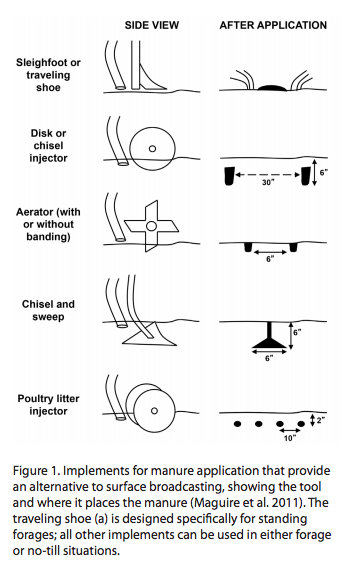
Effects of Manure Application Method on Key Factors
Residue Cover
In no-till, a critical factor is the amount of residue on the soil surface. Surface application of manure does not reduce residue and the manure itself contributes to residue on the surface, which can have a positive impact on soil erosion. Tillage and conventional chisel-type applicators often bury a significant proportion of the residue. Shallow-disk injectors and aerator applicators can have relatively minimal negative impact on surface residue.
There can be a large amount of variation in the amount of residue that remains on the surface from one piece of equipment to another, depending on how the equipment is configured and adjusted. This should be an important consideration in selecting no-till manure injection equipment and setting it up to minimize surface residue disturbance. In most cases, the goal is to have at least 30 to 50 percent residue cover on the soil surface when the crop is established.
Nitrogen Losses from Ammonia Volatilization
Ammonia volatilization is often the No. 1 concern for the farmer in no-till manure management. More studies have looked at the effect of manure application technique on ammonia volatilization than on nutrient losses in runoff (table 1). Many studies have shown that surface application of manure can lead to large ammonia losses and that tillage can substantially reduce these losses if done close to the time of manure application.
Most of the ammonia loss occurs in the first 24 hours after application. It is important to realize that this is very much affected by the weather. A common observation with manure injection is that the amount of ammonia volatilization is directly related to the amount of manure exposure on the soil surface. Thus, injecting manure is an effective method of reducing ammonia volatilization in most situations, as long as the manure is not exposed on the soil surface.
Volatilization from injection can be significant if the rate is too high and the manure cannot be contained in the injection slit, or if the covering mechanism on the injector is not covering the injection slit due to design or adjustment problems. Losses can also be high if manure is injected in wet or compacted soils due to poor slit closure, leaving the manure exposed. Knife injectors or shallow-disk injectors — if designed and set up properly to cover the manure — reduce volatilization more than tools that only partially incorporate the manure, such as with aerators.
One challenge with interpreting studies with aerators is that they can be used in many different configurations, which can result in very different impacts on ammonia volatilization. In most work with aerators in no-till, the aerators are run straight to just make pockets in the soil to enhance manure infiltration with minimal soil disturbance. This is where ammonia losses are highest. Angling the aerator gangs to do more aggressive tillage has been shown to be effective for reducing ammonia losses. However, this more aggressive tillage will reduce residue cover and can increase sediment losses.
Sediment Losses in Runoff
It is well-established that cultivation increases sediment losses in runoff — both immediately following tillage and over the long term as soil becomes crusted and there is surface sealing (table 2). Applying manure in a way that minimizes soil disturbance and maintains surface residue on the soil should also minimize sediment losses. As noted above, surface application of manure can increase surface residue and thus reduce sediment loss, but it also exposes the manure nutrients to surface runoff and volatilization losses as is discussed below. Both shallow disk injectors and aerator applicators have been shown in research to reduce sediment losses while tillage and higher disturbance injectors, such as chisel injectors, generally increase sediment loss.
However, this is not always the case. At times, sediment loss has increased with the low-disturbance injectors. This can often be explained by how the applicator is configured. Higher speeds have been shown to increase the disturbance and, consequently, the sediment loss potential.
Also, soil properties can play a role. For example, soil compaction and soil drainage have been shown to impact sediment loss with aerators because of the impact these soil properties can have on runoff volume.
Phosphorus Losses in Runoff
In general, the potential for soluble P runoff loss is greatest with surface-applied manure because runoff generated by rainfall shortly after application will be in direct contact with the manure. The runoff can relatively easily extract the water-soluble P from the manure and carry it off the field. The loss of soluble P from surface-applied manure decreases with time, but the losses in the first rainfall event can make up a large proportion of the total P losses.
Tillage to incorporate the manure usually results in lower soluble P losses in runoff, but this is typically offset by increased losses of sediment-bound P with the increased erosion due to the tillage (table 2). If manure can be placed below the soil surface to minimize contact with runoff water without increasing erosion, soluble P losses from the manure can be minimized. Thus, minimal-disturbance manure injection can reduce total P loss.
Shallow disk injectors that place the manure below the surface with minimal disturbance have been shown to dramatically reduce soluble P loss. However, if there is significant soil disturbance, this can be offset by higher sediment P loss. For the studies available, injection of manure has consistently decreased soluble P loss and, often, total P in runoff. No studies have shown low-disturbance manure injection to increase P in runoff relative to surface applications. This suggests that manure injection is a very promising technology for decreasing P in runoff.
Aerator applicators have shown more mixed impacts on dissolved P losses. The aerator applicators do not place the manure below the soil surface, thus it remains exposed to runoff. However, aerators can reduce the amount of runoff, which will reduce the loss of soluble P. The key factor here seems to be the soil properties. In well-drained soils, aerators have been shown to dramatically reduce runoff and, thus, soluble P loss. However, losses of soluble P in runoff have been observed to increase in poorly drained soils where manure was applied with an aerator. This is an area where more research is needed.
Nitrogen Losses in Runoff
Soluble N loss in runoff is similar to soluble P loss. Direct exposure of manure to runoff increases soluble N loss in runoff. While the results of research on N losses in runoff are generally similar to what was discussed above with P, because of the extremely dynamic behavior of N in the soil, research results on the effect of these manure application systems on N runoff in no-till show greater variability.
For example, lower N losses in runoff may simply be due to higher volatilization losses, reducing the N available for loss in runoff. The few studies available suggest that manure injection is a promising technology for decreasing N losses in runoff.
However, reducing N losses in runoff may increase N leaching losses, particularly if the mechanism of reduction is to reduce runoff volume and thus increase water infiltration and percolation.
Nitrogen Losses by Leaching
The literature on leaching losses of N related to manure application in no-till is very scarce. However, reducing N losses in runoff and volatilization may increase N leaching losses by retaining more N in the soil that can be leached. Leaching loss would also be expected to increase if the mechanism of reduction of runoff losses was to reduce runoff volume and thus increase water infiltration and percolation, as with aerators run straight.
Odor
Odor issues are becoming more common due to urbanization of agricultural areas, although measurements are difficult. Significantly greater odor is usually detected for surface-applied manure than injected manure. Injecting manure could decrease odor compared to surface applications, depending on type of injector.
For liquid dairy manure, for example, one study showed that odor decreased in the following order:
surface broadcast > aeration infiltration > surface +
chisel incorporation > direct ground injection ≈ shallow disk injection > control.
Management practices that reduce ammonia volatilization (as discussed above) will likely also reduce odor, but no studies have evaluated both components simultaneously.
Nitrogen Uptake, Yields, and Rooting Issues
In situations where manure has been injected, few problems with crop yields have been reported for row crops. In fact, when N is limiting, practices such as injection — that decrease ammonia volatilization — often increase yields due to greater plant-available N. In row crops, a common question is the effect of planting in or near the injection zone, especially when shallow injection in no-till is used. In general, research has shown that shallow injection had no negative effects on
row crops, even when the crop rows are very close to or even cross the manure injection band.
The rate of injection is important. There have been examples of negative effects on the crop when high rates of manure are banded near the row. Common recommendations are to delay planting for a week or so after injection to minimize this potential problem. It is unclear whether this is necessary under all conditions. In fact, one research project found that injecting separated manure solids near the cornrow at planting time had a significant, beneficial starter effect.
In forages, it has been found that manure applications with soil aeration can decrease or increase yield compared to surface application of manure. It is generally thought that this may be due to injury to the forage stand from the injector. These inconsistent effects may have been due to different weather conditions, soil moisture, and time of year when the injection was conducted.
Also, as has been mentioned before, the configuration of the injectors or aerators could be responsible for greater or lesser injury to the forage crop. For example, wider spacing on shallow-disk injectors or running aerator applicators with no angle seems to result in less crop injury.
Economics
Relative to surface broadcasting, the economic benefit of manure injection is related to the decrease in ammonia volatilization, which leads to greater plant-available N from the manure applied. Ammonia loss is weatherrelated, so injection also decreases the variability in predicting plant-available N. The economic drawbacks are increased equipment costs and slower application rates. While economic data with manure injection in no-till systems are scarce, a few studies have indicated that the costs of low-disturbance injection can be offset by reductions in nutrient loss without adversely affecting farm profitability.
Table 3 summarizes data from a farm run by Mr. Beery in the Shenandoah Valley of Virginia, where fields were about 1 mile from the dairy manure lagoon. The study found that injecting manure could be done for a modest additional cost per acre if the assumed amount of N can be recovered. Although the swath of the injection unit was narrower than that of surface application, the tractor could drive faster because the manure pumping rate limited the surface application driving rate.
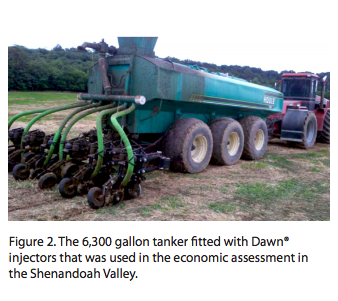
A nurse tank could also be used to transport manure from the pit and then transfer it to the injection equipment so it could stay in the field. When using a nurse tank and injecting, the application rate was very close to the broadcast rate in acres per hour covered; however, the cost per acre was higher. The net cost per acre when injecting without the nurse tank — after factoring in the captured N — was actually less than the broadcast cost due to increased nitrogen recovery. However, the acres per hour covered dropped more than 20 percent.
If the spreading window is large enough, injection can be done without the nurse unit. But typically, especially for custom operators, the fewer acres per hour are not acceptable because weather and other issues limit the available time to spread. A shorter distance would have made the nurse truck unnecessary, while a greater distance would have made it more important.
Does Injection Increase Soil Carbon?
Anecdotal evidence points to conservation of organic matter, as shown in figure 2. This dark, organic matter tube was rich in roots because roots flourish in nutrient-rich areas. The organic matter in the injection slit at the end of the growing season has been witnessed at several sites in the Shenandoah Valley, but it is very
difficult to quantify due to spatial variability and large existing soil organic matter versus relatively small applications of carbon in manure.
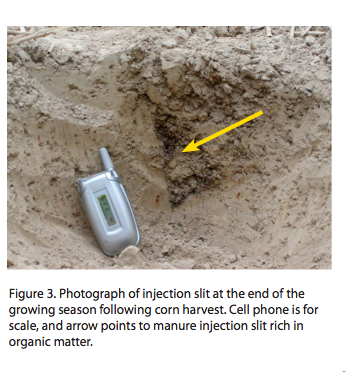
Additional Information
For more detailed information and literature references, see the following review article.
Maguire, R. O., P. J. A. Kleinman, C. J. Dell, D. B. Beegle, R. C. Brandt, J. M. McGrath, and Q. M. Ketterings. 2011. “Manure Application Technology in Reduced Tillage and Forage Systems: A Review.” Journal of Environmental Quality 40:292-301.

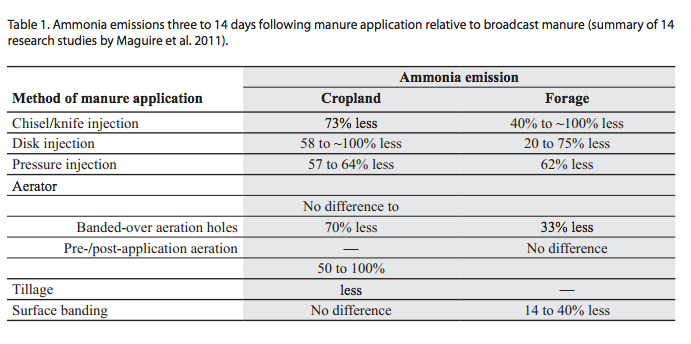
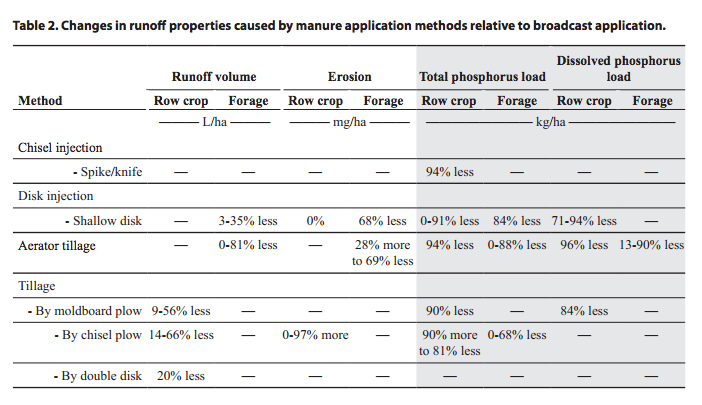
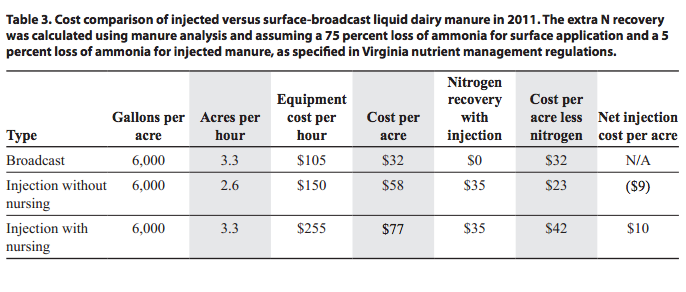





Post a comment
Report Abusive Comment